elnézést előbbi hozzászólásomért, a képek nagyobbak voltak, mint azt első látásra meg lehetett állapítani. Ha egy modi kiszedné hálás lennék.
ismétlés, ezúttal hátha jobban sikerül :))
Mikor ér véget a kéj-utazás?
When Will the Joy Ride End?
By Randy Udall, 1999
BLACK MAGIC. During the last century oil has transformed the world. British coal launched the Industrial Revolution, but American oil put the pedal to the metal.
Fekete Mágia. A Brit szén elindította az ipari forradalmat, de az Usák olaj tette a "pedált a metálra" :))
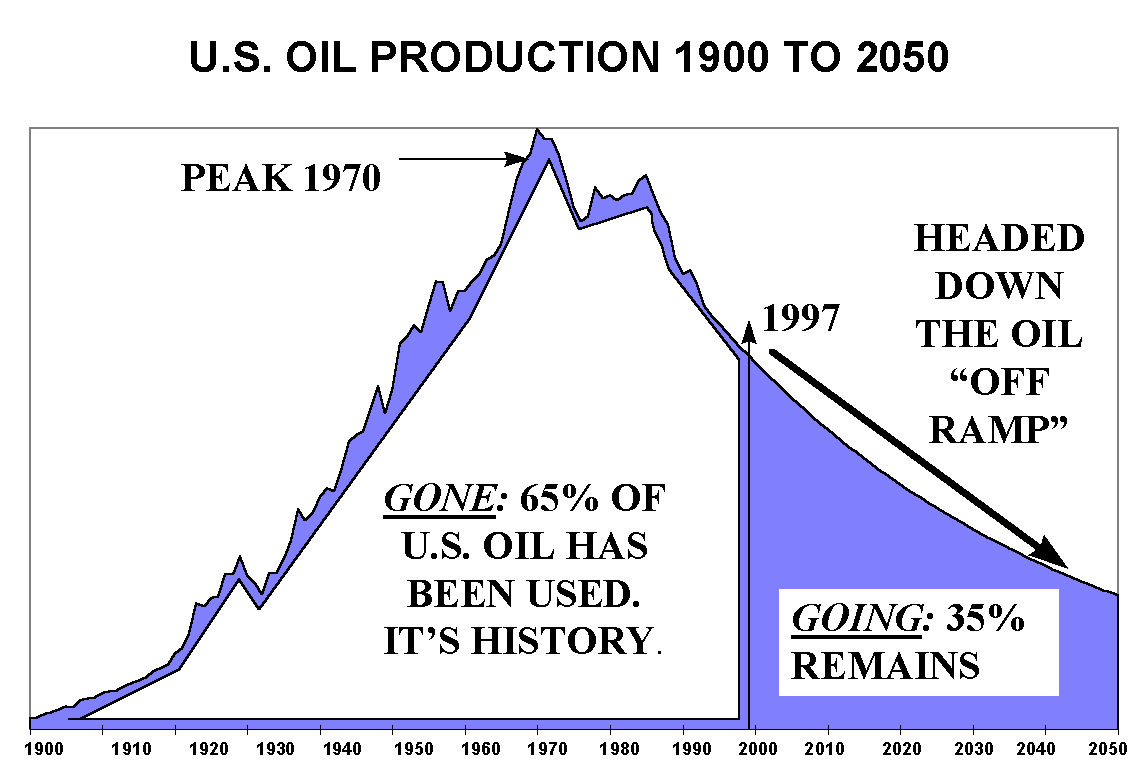
BLESSED BY GEOLOGY. Cheap oil has always been an American birthright. Through fate and geology, the United States was extravagantly blessed. Our original cargo was about 260 billion barrels; only one country, Saudi Arabia, had more. Oklahoma alone possessed more oil than Germany or Japan. California had more than Germany, Japan, France, Spain, Denmark, Sweden, Finland, and Italy combined. The U.S. has—or rather had—20 times as much oil as India, 16 times as much as Brazil, 3 times more than China. From 1859 to 1939 the U.S. produced two-thirds of the world’s oil. After Japan attacked Pearl Harbor in oil-starved desperation and Hitler failed to capture Russia’s Baku oil field, American petroleum, and the industrial output it nourished, triumphed in World World War II.
Geológia által megáldva. Az Usákok olcsó olajba születtek. Olajtartalékaik 260 Gb-t tettek ki, csak Szaud-Arábia rendelkezett hozzájuk mérhető tartalékkal. A II. világháborút az olajnak köszönhetően tudták megnyerni.
Mostanra (1997) azonban már 65%-ban nyakára hágtak a tartaléknak, maradt 35%.
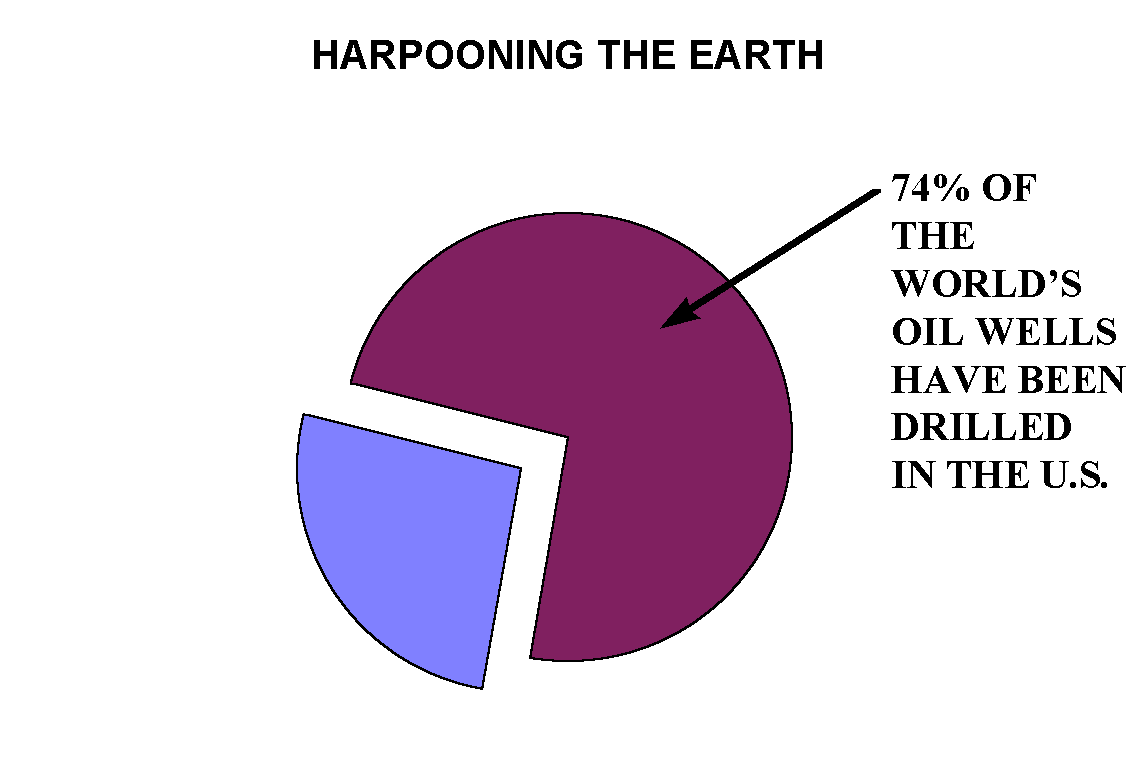 SWISS CHEESE. Well, ok, if Pennsylvania and Texas are played out, why not drill more wells somewhere else? In fact, the U.S. is already one of the most thoroughly explored and drilled countries on Earth. Of the 4.6 million wells worldwide, 3.4 million have been drilled in this country. Very very few prospects remain. With the exception of the Arctic National Wildlife Refuge and a few deep water basins, we’ve been there and done that. From the oil industry’s perspective, the U.S. is Swiss cheese.
SWISS CHEESE. Well, ok, if Pennsylvania and Texas are played out, why not drill more wells somewhere else? In fact, the U.S. is already one of the most thoroughly explored and drilled countries on Earth. Of the 4.6 million wells worldwide, 3.4 million have been drilled in this country. Very very few prospects remain. With the exception of the Arctic National Wildlife Refuge and a few deep water basins, we’ve been there and done that. From the oil industry’s perspective, the U.S. is Swiss cheese.
Svájci Sajt. A világ 4,6 millió olajkútja közül 3,4 millió Usákiában található. Eszmei modanivaló: ha elfogyott az olaj, akkor hiába lyuggatjuk ki a földet mint egy sájci sajtot, attól nem lesz több.
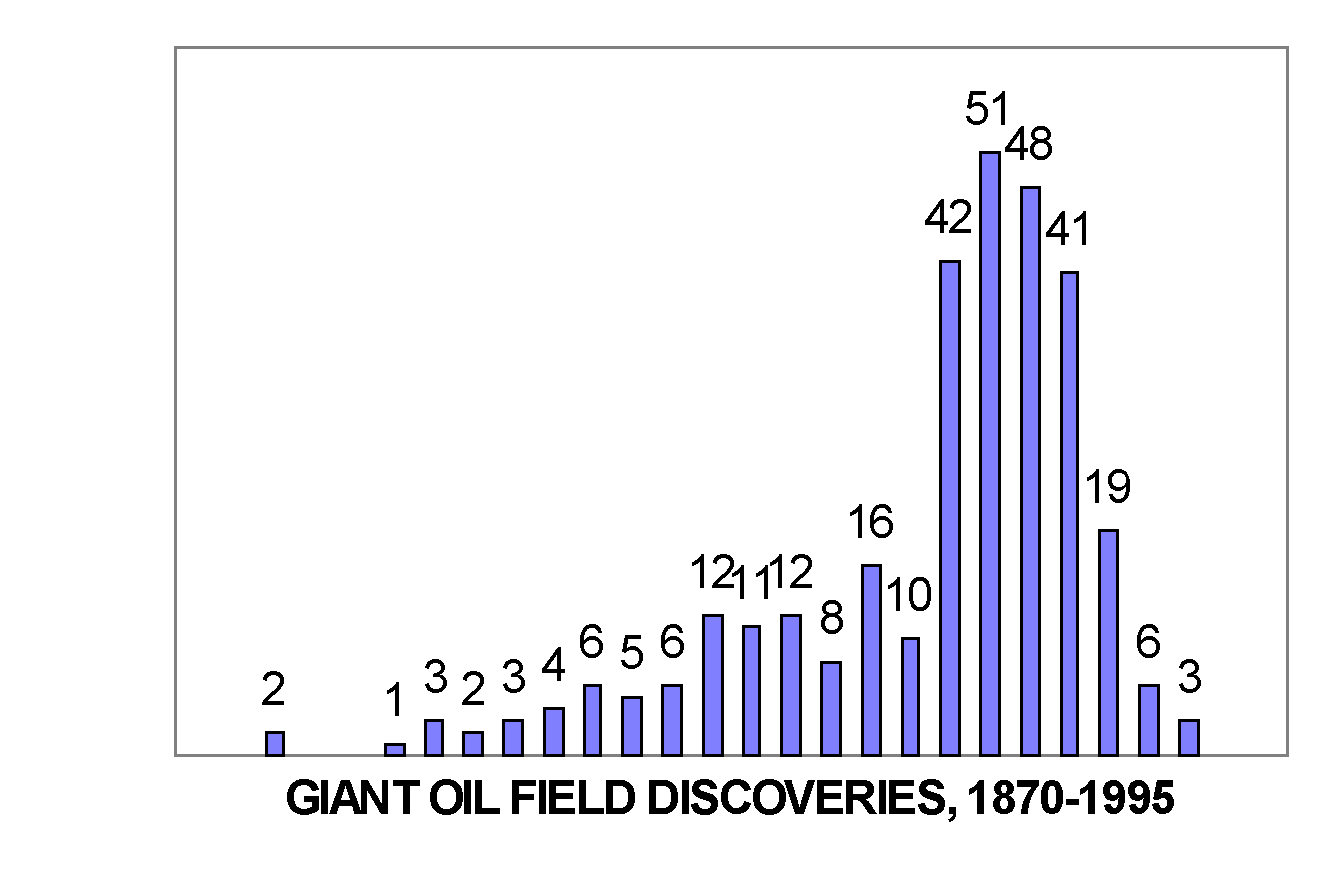
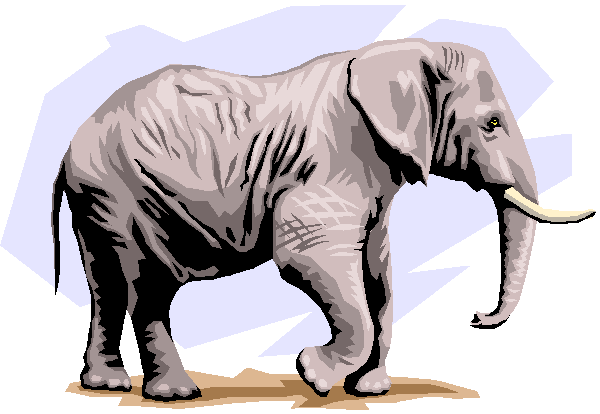
HUNTING ELEPHANTS. Ghawar. Burgan. Safaniya-Khafji. Zakum. These are the strange, unfamiliar names of the four largest oil fields in the world. Oil occurs rarely in nature and when it does it’s often concentrated in large amounts. About 70% of the world’s petroleum is found in 370 giant fields, nicknamed "elephants" because they are so huge. Western civilization—life as we know it—is based on these elephants. In part because they are so big, the elephants were easy to find and inexpensive to produce. (To get oil out of Ghawar, for example, costs the Saudis less than $1 per barrel.) The discovery rate for elephants peaked in the 1960s. It’s getting harder and harder to find new ones. Indeed, many geologists believe that elephants are nearing extinction, that only a handful remain unfound.
Elefánt-vadászat. A világ olajtermelésének 70%-át 370 Gigantikus olajmező adja, amelyeket "Elefántoknak" becéznek. Az "Elefántokat" könnyű megtalálni, és olcsó kitermelni. Legtöbb "Elefántot" a 60-as években fedezték fel, manapság csak elvétve találnak egyet-egyet. Mára már az összes "Elefántot" levadászták - állítják a geológusok.
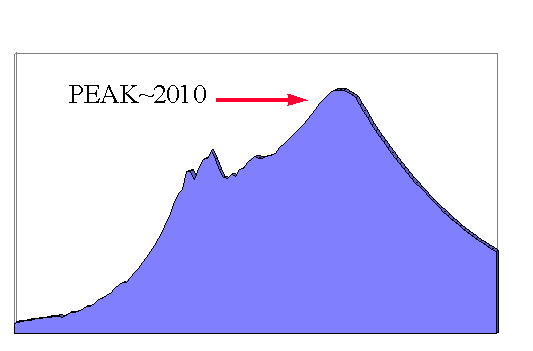
THE COMING PEAK. In the same way that U.S. oil production peaked in 1970, global production is destined to peak during the first two decades of the coming century. Some analysts expect a peak around 2005; some suggest it will be 2010; others believe it will come as late as 2020. The exact date can’t be predicted, since it will depend as much on economic and political factors as on geology. The biggest wild card? Saudi Arabia, the world’s most prolific oil province. If the Saudis invest hundreds of billions of dollars they could double their output to meet expected demand. But they may decide not to double production, choosing instead to produce somewhat less oil and charge more for it. Although predicting the peak is impossible, this great turning point is imminent.
Jön a csúcs! Egyesek szerint 2005-ben, mások szerint 2010-ben, de legkésőbb 2020-ban itt lesz a Csúcs. A kérdőjel Szaud-Arábia. A Szaudok pár száz milliárd dolláros befektetéssel meg tudnák duplázni a kitermelést és egy ideig még lépést lehetne tartani a folyamatosan növekvő igényekkel. Ez azonban ellenmondana a közgazdasági 1x1-nek. Hatalmas vagyonokat befektetni azért, hogy rövid ideig tartó csekély profitra tegyenek szert, amikor a nem-befektetés hosszú ideig tartó hatalmas profitokat feltételez?
Ezen utóbbi esetben azt kockáztatják azonban, hogy "okos menedzserek" helyett "gonosz terroristák" lesznek, annak minden következményével...
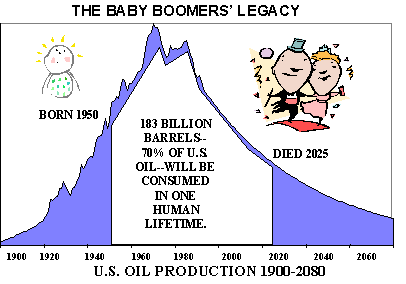
More than half the world’s oil—and 70% of U.S. oil—will be consumed during a single human lifetime. That span happens to coincide with the Baby Boomer generation born after World War II. The graph at left shows the phenomenon. The Boomers were conceived as auto culture kicked into overdrive. As newborns, they were driven home from the hospital in a car. They grew up listening to songs like Mustang Sally and Little GTO. Getting a driver’s license was their rite of passage. During their lives many Baby Boomers will drive and fly a million miles, equal to 40 trips around the globe. Magellan and Amelia Earhart were the famous circumnavigators of their day. Now every man is Magellan, every woman Amelia.
Az 1950-ben születettek egy generáción belül Usákia olajának 70%-át elfogyasztják.
Szerencsések és felelőtlenek.
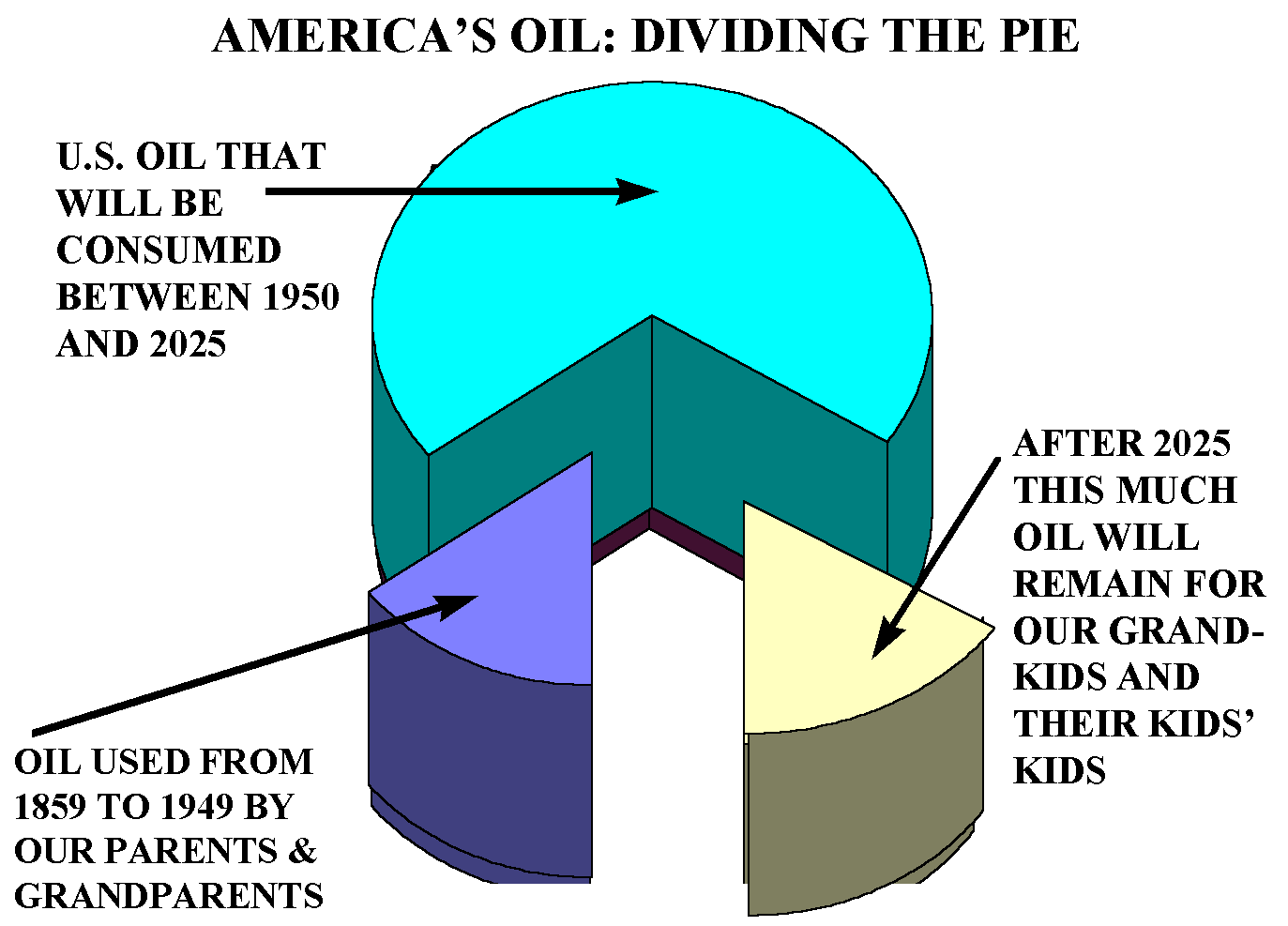
SLICING THE PIE. Geologists estimate that U.S. oil production will ultimately total 260 billion barrels. A sliver of that pie was consumed between 1859 and 1949, the first 90 years of the Oil Era. A much larger slice—if we can call 70% of the pie a slice—will be used between 1950 and 2025. Our grandchildren and their kids’ kids will inherit what’s left. By 2025, when U.S. population will exceed 300 million, just 15% of U.S. oil will remain.
Az OlajTorta Felszeletelése. A nagymamák és nagypapák kapnak egy 15%-os szeletet, az 1950-ben született generáció kap egy 70%-os szeletet, az unokák és leszármazottaik megkapják a maradék 15%-os szeletet.
 WE’VE SHOT ALL THE BUFFALO NOW WHAT DO WE DO? In 1872 there were 15 million bison roaming the Great Plains. A decade later only a thousand were left. Pelt hunters had ruthlessly slaughtered the rest. The heedless waste, the bloodthirsty savagery seems criminal today. I wonder if future generations will view our pell-mell liquidation of oil, arguably Earth’s most valuable resource, as equally senseless, shortsighted, and greedy. If there were a ready substitute that would be one thing. But there isn’t. In fact, there is no substitute for oil in the ways and volumes in which we use it today. Petroleum is a gift of geology, a one-time windfall—and we’re spending it like there’s no tomorrow.
WE’VE SHOT ALL THE BUFFALO NOW WHAT DO WE DO? In 1872 there were 15 million bison roaming the Great Plains. A decade later only a thousand were left. Pelt hunters had ruthlessly slaughtered the rest. The heedless waste, the bloodthirsty savagery seems criminal today. I wonder if future generations will view our pell-mell liquidation of oil, arguably Earth’s most valuable resource, as equally senseless, shortsighted, and greedy. If there were a ready substitute that would be one thing. But there isn’t. In fact, there is no substitute for oil in the ways and volumes in which we use it today. Petroleum is a gift of geology, a one-time windfall—and we’re spending it like there’s no tomorrow.
LELŐTTÜK AZ ÖSSZES BÖLÉNYT - HOGYAN TOVÁBB?
Az ember azt gondolná, hogy az emberiség nem lehet ennyire ostoba. Pedig igen. 1872-ben 15 millió bölény rohangált Usákia-szerte. Egy évtizeddel később maradt 1000. Aztán azokat is lelőtték. Azóta sem sikerült megtalálni a bölény helyettesítőjét - de ha találtak is valamit, azt mind olajból állítják elő.
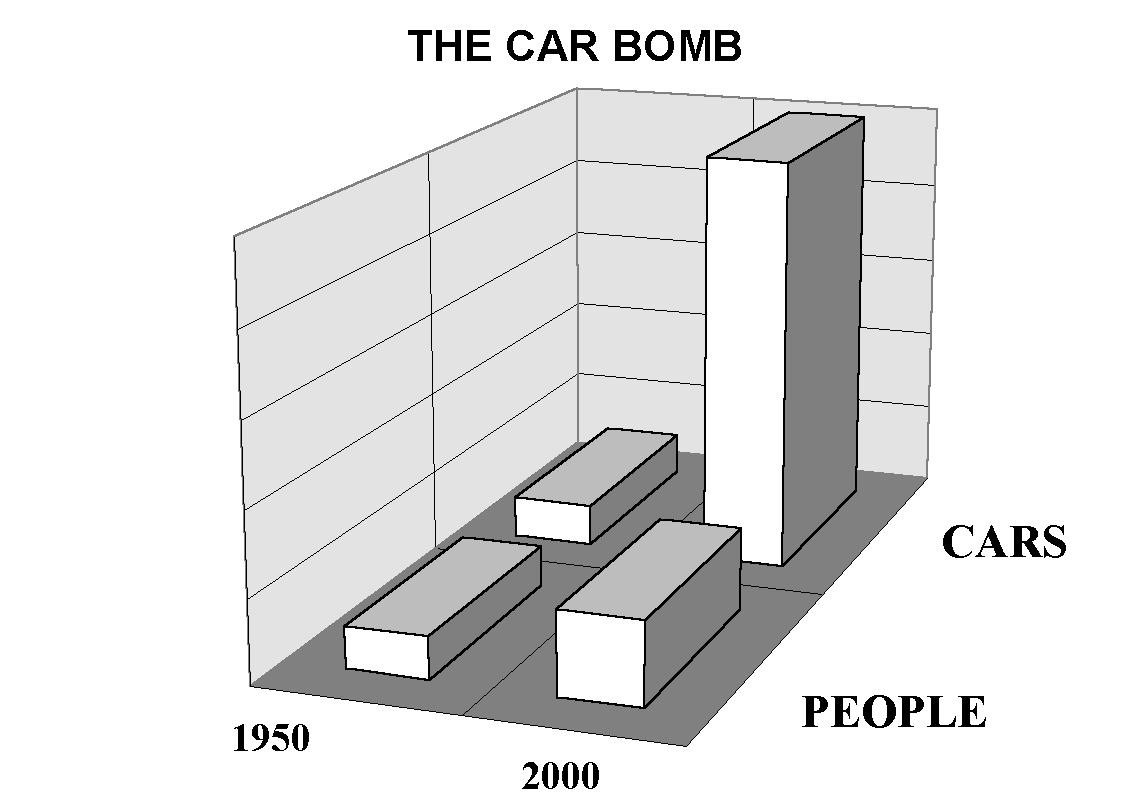
CAR BOMB. You hear about the population explosion. And yes, the population has doubled from 3 billion to 6 billion since 1950. In the same period, car numbers shot up from 50 million to 500 million. Cars, in other words, are reproducing five times faster than people. They’re breeding like (VW) Rabbits.
Autó Bomba. Népességszaporulatról sokat hallani, és az autószaporulatot méltánytalanul mellőzzük. 1950 óta megduplázódott a népesség - 3 milliárdról 6 milliárdra. Ugyanezen időszak alatt az autók száma 10-szeresére növekedett - 50 millióról 500 millióra. Úgy szaporodnak az autók mint a nyulak :))

REALITY CHECK. Which nations have oil and which nations use it? Fully two-thirds of the world’s oil is in five Muslim countries. The chart at right explains why Iraq’s Saddam Hussein gets press, why the State Department frets about Iran, why the U.S. military did not leave Saudi Arabia after the 1990 Gulf War, and why we fought that war in the first place. (George Bush: "Our way of life is at stake.") America’s future, Japan’s future, Europe’s future, China’s future, Europe’s future…all are inextricably linked to the Middle East. In the deserts of Saudi Arabia, the U.S. military is building fortified air bases. Ostensibly we are there to protect our Saudi friends. In reality, we are an occupying force protecting our access to their oil. Some Saudis are resentful of our presence, as we would be if they were building air bases in Nevada. Would we leave their county if asked? I wonder. My son is 7. He’ll be 18, fighting age, in 2009, about the time an Oil Crunch may arrive.
Való Világ. A világ olajkészleteinek 2/3-a 5 iszlám országban található. Az Usák hadsereg jelenléte a Perzsa öbölben biztosítja Usákiának a létfontosságú olajat. Vannak Szaudiak, akik nem örvendenek annak, hogy az Usákok katonai bázisokat építenek országukban, mint ahogy az Usákok sem örvendenének, ha a Szaudok építenének bázisokat Nevadában. A fiam 7 éves. 2009-ben, az OlajRobbanás idején 18 éves lesz - sorköteles.
DOOMERS & BOOMERS. World oil experts fall into two camps, pessimists and optimists. It’s striking how little difference there is between them. Both camps agree we’ve already used 800 billion barrels. The pessimists, or doomers, think there’s one trillion left and that oil production may peak by 2005. Boomers believe there’s 1.8 trillion left and that production will peak in 2020. If fifteen years is the only difference between pessimists and optimists, perhaps we ought to begin planning for a world in which oil is not as abundant as it is today.
Optimisták és Pesszimisták. A Pesszimisták szerint az 2005-ben üt az OlajÓra, az Optimisták szerint "csak" 2020-ban. A különbség 15 év.
LIFE IN 2050. By 2050 a world of perhaps 9 billion people will be consuming only as much oil as 3 billion did in 1950. There will be three times less oil per person. Oil will be more expensive. Is this a Doomsday message? Not necessarily. A more sustainable world may actually be a better place in which to live. The difficulty is getting from here to there.
2050-ben 9 milliárd ember fog annyi olajat fogyasztani, mint 3 milliárd 1950-ben.
Világvége?
Nem feltétlenül.
Elméletileg elképzelhető egy fenntartható életforma, egy jobb világ.
De oda el kéne jutni.
Azonban az illetékes elvtársak még csak szembe sem mernek nézni a problémával.
